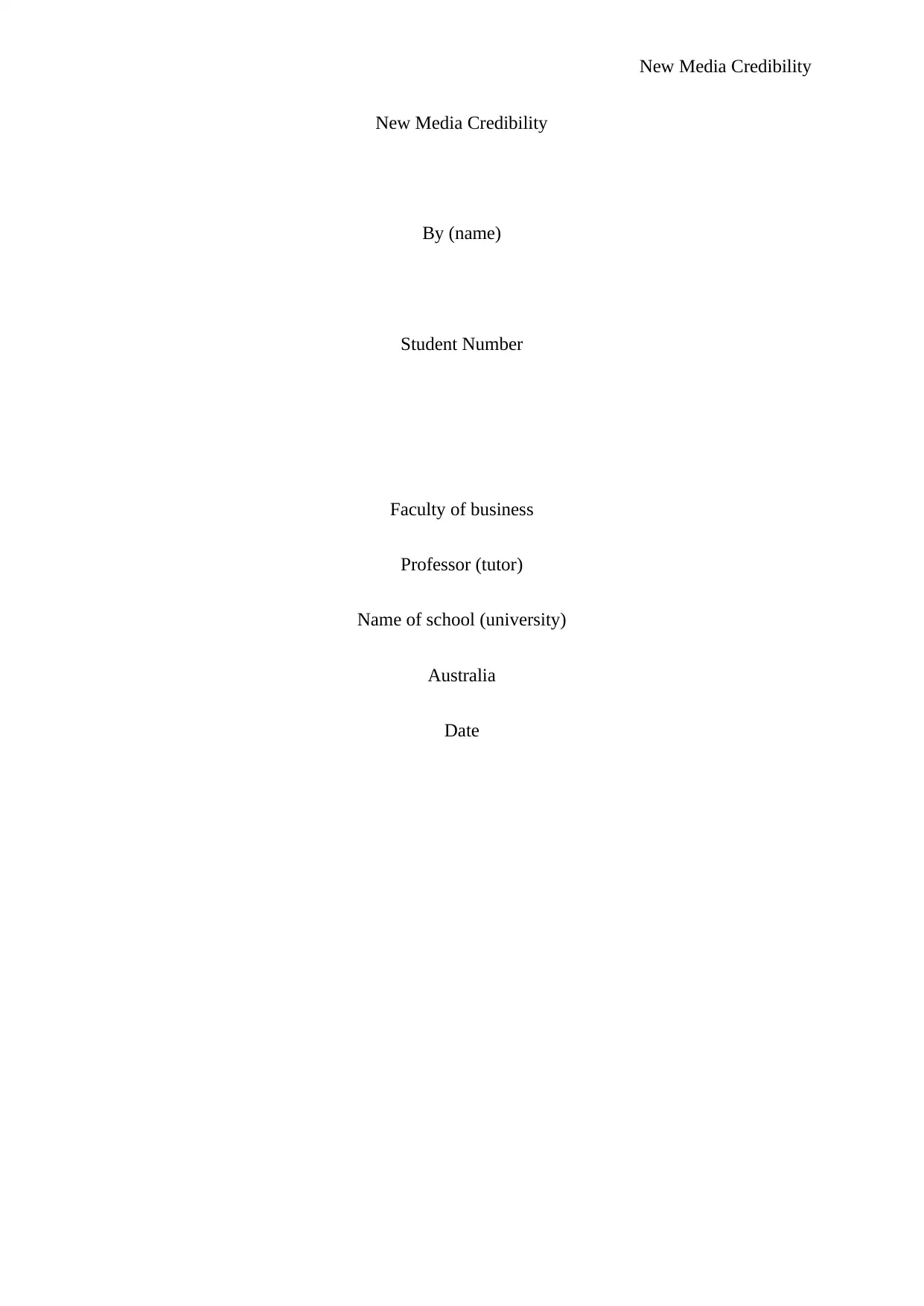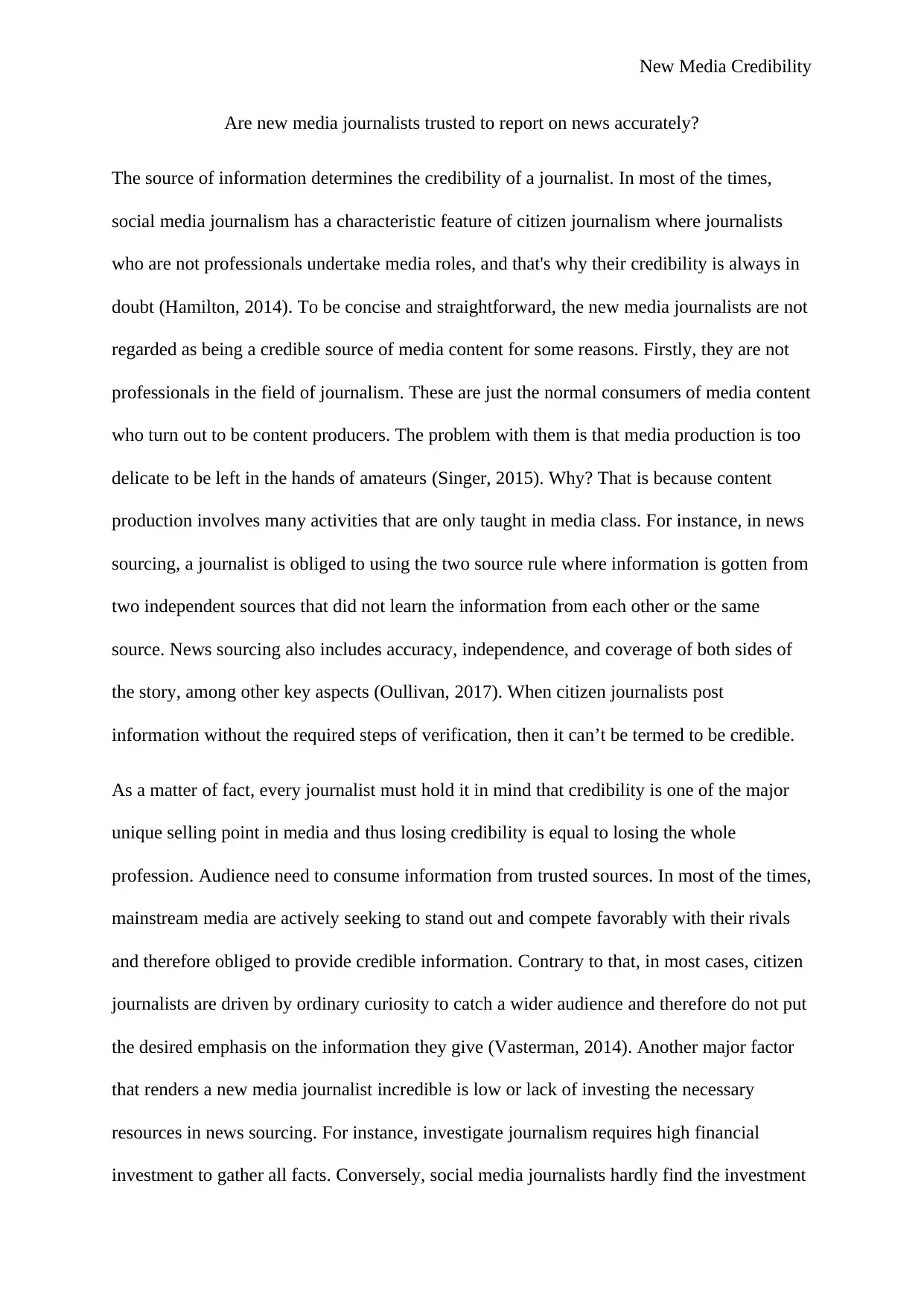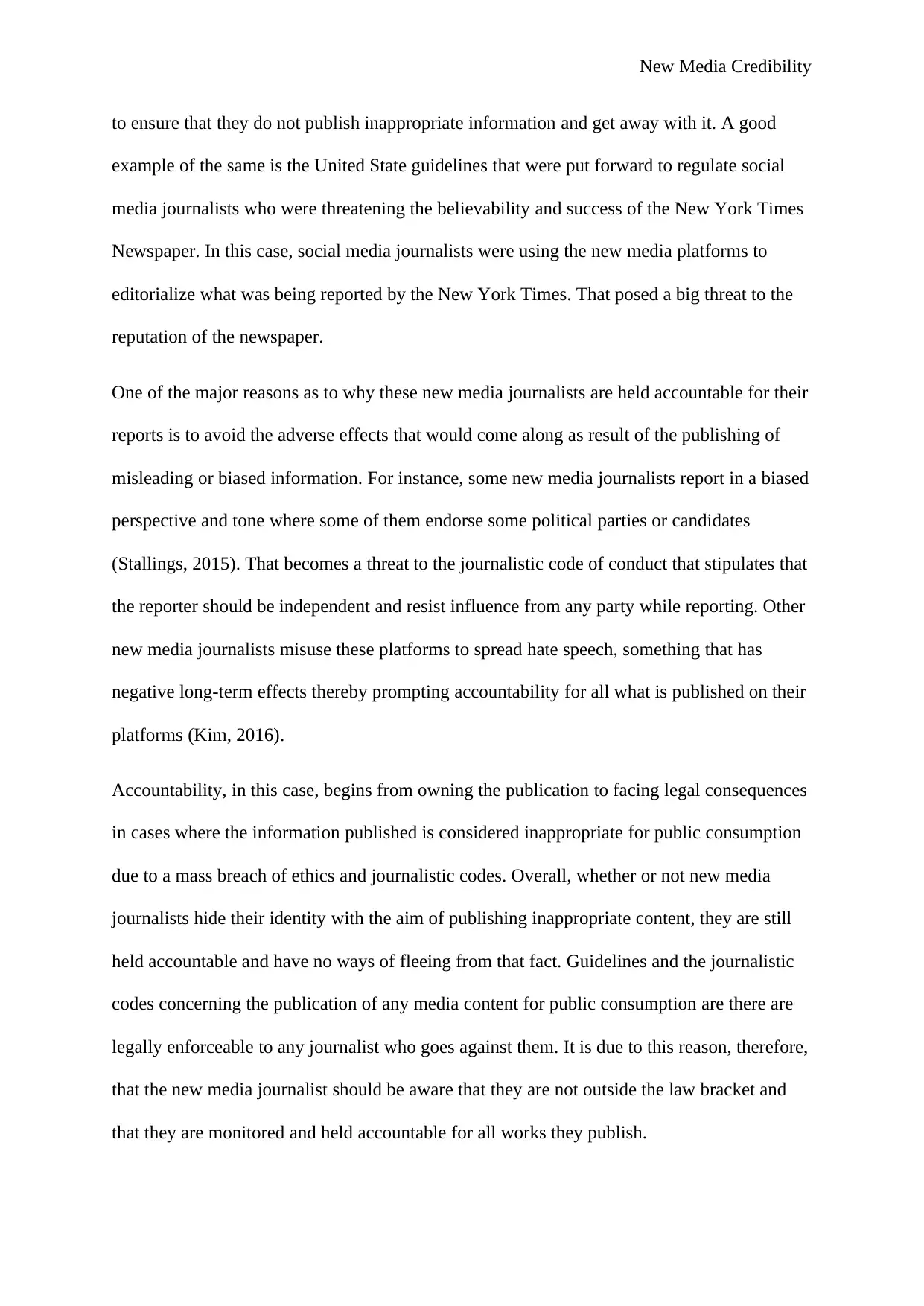Assessing New Media Journalism: Trust and Reporting Accuracy Focus
VerifiedAdded on 2023/06/12
|8
|2041
|55
Essay
AI Summary
This essay critically examines the credibility of new media journalism, questioning whether new media journalists are trusted to report news accurately. It argues that due to the prevalence of citizen journalism, lack of professional training, and insufficient resource investment in news sourcing, new media journalists often fall short of established journalistic standards. The essay highlights issues such as failure to adhere to the two-source rule, lack of verification, bias, sensationalism, and inadequate attribution. It further discusses the accountability of new media journalists for their reports, emphasizing that they are increasingly held responsible for the information they publish, despite operating outside traditional media structures. The analysis concludes that while mainstream media is more heavily regulated, new media journalists are also subject to guidelines and legal actions for unethical or inaccurate reporting. Desklib offers a range of resources for students studying media and journalism.

New Media Credibility
New Media Credibility
By (name)
Student Number
Faculty of business
Professor (tutor)
Name of school (university)
Australia
Date
New Media Credibility
By (name)
Student Number
Faculty of business
Professor (tutor)
Name of school (university)
Australia
Date
Paraphrase This Document
Need a fresh take? Get an instant paraphrase of this document with our AI Paraphraser

New Media Credibility
Are new media journalists trusted to report on news accurately?
The source of information determines the credibility of a journalist. In most of the times,
social media journalism has a characteristic feature of citizen journalism where journalists
who are not professionals undertake media roles, and that's why their credibility is always in
doubt (Hamilton, 2014). To be concise and straightforward, the new media journalists are not
regarded as being a credible source of media content for some reasons. Firstly, they are not
professionals in the field of journalism. These are just the normal consumers of media content
who turn out to be content producers. The problem with them is that media production is too
delicate to be left in the hands of amateurs (Singer, 2015). Why? That is because content
production involves many activities that are only taught in media class. For instance, in news
sourcing, a journalist is obliged to using the two source rule where information is gotten from
two independent sources that did not learn the information from each other or the same
source. News sourcing also includes accuracy, independence, and coverage of both sides of
the story, among other key aspects (Oullivan, 2017). When citizen journalists post
information without the required steps of verification, then it can’t be termed to be credible.
As a matter of fact, every journalist must hold it in mind that credibility is one of the major
unique selling point in media and thus losing credibility is equal to losing the whole
profession. Audience need to consume information from trusted sources. In most of the times,
mainstream media are actively seeking to stand out and compete favorably with their rivals
and therefore obliged to provide credible information. Contrary to that, in most cases, citizen
journalists are driven by ordinary curiosity to catch a wider audience and therefore do not put
the desired emphasis on the information they give (Vasterman, 2014). Another major factor
that renders a new media journalist incredible is low or lack of investing the necessary
resources in news sourcing. For instance, investigate journalism requires high financial
investment to gather all facts. Conversely, social media journalists hardly find the investment
Are new media journalists trusted to report on news accurately?
The source of information determines the credibility of a journalist. In most of the times,
social media journalism has a characteristic feature of citizen journalism where journalists
who are not professionals undertake media roles, and that's why their credibility is always in
doubt (Hamilton, 2014). To be concise and straightforward, the new media journalists are not
regarded as being a credible source of media content for some reasons. Firstly, they are not
professionals in the field of journalism. These are just the normal consumers of media content
who turn out to be content producers. The problem with them is that media production is too
delicate to be left in the hands of amateurs (Singer, 2015). Why? That is because content
production involves many activities that are only taught in media class. For instance, in news
sourcing, a journalist is obliged to using the two source rule where information is gotten from
two independent sources that did not learn the information from each other or the same
source. News sourcing also includes accuracy, independence, and coverage of both sides of
the story, among other key aspects (Oullivan, 2017). When citizen journalists post
information without the required steps of verification, then it can’t be termed to be credible.
As a matter of fact, every journalist must hold it in mind that credibility is one of the major
unique selling point in media and thus losing credibility is equal to losing the whole
profession. Audience need to consume information from trusted sources. In most of the times,
mainstream media are actively seeking to stand out and compete favorably with their rivals
and therefore obliged to provide credible information. Contrary to that, in most cases, citizen
journalists are driven by ordinary curiosity to catch a wider audience and therefore do not put
the desired emphasis on the information they give (Vasterman, 2014). Another major factor
that renders a new media journalist incredible is low or lack of investing the necessary
resources in news sourcing. For instance, investigate journalism requires high financial
investment to gather all facts. Conversely, social media journalists hardly find the investment

New Media Credibility
of funds in their news sourcing irrelevant due to the less or no economic benefits associated
with their information dissemination. As a result, therefore, they are not driven by the sense
of credibility and thus sometimes give information with squinting information and dangling
evidence (Sallot, 2017). It should be appreciated that media is characterized by showing and
not telling. The fact that most of the new media journalists tell and not show fuels
incredibility. Again, new media sources do kit have diverse sources of information and thus
rely on single sources for quite some time. Since they don’t want to seem the same every day,
they end up using their creativity to modify their information to suit the growing need of their
audience thereby losing originality of information yet hard news re not opinionated or
modifiable.
One of the major facts that need to be put into account is that credible journalism comes with
attribution of information to sources even if the facts have been verified. Most of the new
media reporters do not put into consideration this virtue of credible journalistic practice and
therefore end up giving information that is not credible and fit for public consumption.
Sometimes the sources insist in giving information on background or on deep background but
these reporters do not take time to weigh whether having the source remain anonymous is
justifiable. Due to that reason, they end up hiding the identity of a source with no compelling
reasons. This practice is one of the things that render them incredible. Other social media
journalists have the tendency of getting rumors and assigning a hidden source where audience
will not be told where the information was gotten or who said what. These amateurish
practices make them unfit for credible journalism reporting. Another annoying feature of
these citizen journalists is the use is sensationalization to attract audience. Sensationalization
is an old hat that should be avoided at all cost. These journalists use screaming headlines to
attract their audience.
of funds in their news sourcing irrelevant due to the less or no economic benefits associated
with their information dissemination. As a result, therefore, they are not driven by the sense
of credibility and thus sometimes give information with squinting information and dangling
evidence (Sallot, 2017). It should be appreciated that media is characterized by showing and
not telling. The fact that most of the new media journalists tell and not show fuels
incredibility. Again, new media sources do kit have diverse sources of information and thus
rely on single sources for quite some time. Since they don’t want to seem the same every day,
they end up using their creativity to modify their information to suit the growing need of their
audience thereby losing originality of information yet hard news re not opinionated or
modifiable.
One of the major facts that need to be put into account is that credible journalism comes with
attribution of information to sources even if the facts have been verified. Most of the new
media reporters do not put into consideration this virtue of credible journalistic practice and
therefore end up giving information that is not credible and fit for public consumption.
Sometimes the sources insist in giving information on background or on deep background but
these reporters do not take time to weigh whether having the source remain anonymous is
justifiable. Due to that reason, they end up hiding the identity of a source with no compelling
reasons. This practice is one of the things that render them incredible. Other social media
journalists have the tendency of getting rumors and assigning a hidden source where audience
will not be told where the information was gotten or who said what. These amateurish
practices make them unfit for credible journalism reporting. Another annoying feature of
these citizen journalists is the use is sensationalization to attract audience. Sensationalization
is an old hat that should be avoided at all cost. These journalists use screaming headlines to
attract their audience.
⊘ This is a preview!⊘
Do you want full access?
Subscribe today to unlock all pages.

Trusted by 1+ million students worldwide

New Media Credibility
The worst thing is that when the audience get into the real story they find it difficult to
connect the headline with the rest of the story. They also use altered photographs to lure the
attention of the audience into consuming their content, this is not only wrong but also
unethical and against the journalistic code of conduct. Again, it should be appreciated hat the
credibility of information largely depends on how it was collected. Amateur journalists, in
this case, the new media journalists, do not emphasize on the best news of news gathering.
For instance, they do not cover both sides of the story. They only focus on one side of the
story that may have more reception than the other part. This type of reporting is not
professional and loses credibility as it promotes bias and affiliation. It is due to all these
reasons, therefore, that these new media reporters are hardly trusted to report on news
accurately.
Are new media journalists held accountable for their reports?
One of the facts that should be appreciated is that new media journalists are actively
publishing information day and night without regarding the consequence of the information
they publish. All they are aimed at is acquiring cheap publicity and see their reports do well
in the community regardless of whether they are genuine or not. However, this has been the
case, the good news is that the associated authority has been on the track of what has been
transpiring over the social media (Altheide, 2016). While most of them have opted to remain
anonymous and give information without attribution and at times giving incredible
information through fake accounts, they are monitored by the authority to bear their cross in
cases where their reports prove to be contrary to the journalistic code of conduct.
To be simple and straightforward, these journalists are held responsible for all the
information and reports they publish (Williams, 2016). Even though some of them at times
deny their utterances and the information they post, care is taken by the appropriate officials
The worst thing is that when the audience get into the real story they find it difficult to
connect the headline with the rest of the story. They also use altered photographs to lure the
attention of the audience into consuming their content, this is not only wrong but also
unethical and against the journalistic code of conduct. Again, it should be appreciated hat the
credibility of information largely depends on how it was collected. Amateur journalists, in
this case, the new media journalists, do not emphasize on the best news of news gathering.
For instance, they do not cover both sides of the story. They only focus on one side of the
story that may have more reception than the other part. This type of reporting is not
professional and loses credibility as it promotes bias and affiliation. It is due to all these
reasons, therefore, that these new media reporters are hardly trusted to report on news
accurately.
Are new media journalists held accountable for their reports?
One of the facts that should be appreciated is that new media journalists are actively
publishing information day and night without regarding the consequence of the information
they publish. All they are aimed at is acquiring cheap publicity and see their reports do well
in the community regardless of whether they are genuine or not. However, this has been the
case, the good news is that the associated authority has been on the track of what has been
transpiring over the social media (Altheide, 2016). While most of them have opted to remain
anonymous and give information without attribution and at times giving incredible
information through fake accounts, they are monitored by the authority to bear their cross in
cases where their reports prove to be contrary to the journalistic code of conduct.
To be simple and straightforward, these journalists are held responsible for all the
information and reports they publish (Williams, 2016). Even though some of them at times
deny their utterances and the information they post, care is taken by the appropriate officials
Paraphrase This Document
Need a fresh take? Get an instant paraphrase of this document with our AI Paraphraser

New Media Credibility
to ensure that they do not publish inappropriate information and get away with it. A good
example of the same is the United State guidelines that were put forward to regulate social
media journalists who were threatening the believability and success of the New York Times
Newspaper. In this case, social media journalists were using the new media platforms to
editorialize what was being reported by the New York Times. That posed a big threat to the
reputation of the newspaper.
One of the major reasons as to why these new media journalists are held accountable for their
reports is to avoid the adverse effects that would come along as result of the publishing of
misleading or biased information. For instance, some new media journalists report in a biased
perspective and tone where some of them endorse some political parties or candidates
(Stallings, 2015). That becomes a threat to the journalistic code of conduct that stipulates that
the reporter should be independent and resist influence from any party while reporting. Other
new media journalists misuse these platforms to spread hate speech, something that has
negative long-term effects thereby prompting accountability for all what is published on their
platforms (Kim, 2016).
Accountability, in this case, begins from owning the publication to facing legal consequences
in cases where the information published is considered inappropriate for public consumption
due to a mass breach of ethics and journalistic codes. Overall, whether or not new media
journalists hide their identity with the aim of publishing inappropriate content, they are still
held accountable and have no ways of fleeing from that fact. Guidelines and the journalistic
codes concerning the publication of any media content for public consumption are there are
legally enforceable to any journalist who goes against them. It is due to this reason, therefore,
that the new media journalist should be aware that they are not outside the law bracket and
that they are monitored and held accountable for all works they publish.
to ensure that they do not publish inappropriate information and get away with it. A good
example of the same is the United State guidelines that were put forward to regulate social
media journalists who were threatening the believability and success of the New York Times
Newspaper. In this case, social media journalists were using the new media platforms to
editorialize what was being reported by the New York Times. That posed a big threat to the
reputation of the newspaper.
One of the major reasons as to why these new media journalists are held accountable for their
reports is to avoid the adverse effects that would come along as result of the publishing of
misleading or biased information. For instance, some new media journalists report in a biased
perspective and tone where some of them endorse some political parties or candidates
(Stallings, 2015). That becomes a threat to the journalistic code of conduct that stipulates that
the reporter should be independent and resist influence from any party while reporting. Other
new media journalists misuse these platforms to spread hate speech, something that has
negative long-term effects thereby prompting accountability for all what is published on their
platforms (Kim, 2016).
Accountability, in this case, begins from owning the publication to facing legal consequences
in cases where the information published is considered inappropriate for public consumption
due to a mass breach of ethics and journalistic codes. Overall, whether or not new media
journalists hide their identity with the aim of publishing inappropriate content, they are still
held accountable and have no ways of fleeing from that fact. Guidelines and the journalistic
codes concerning the publication of any media content for public consumption are there are
legally enforceable to any journalist who goes against them. It is due to this reason, therefore,
that the new media journalist should be aware that they are not outside the law bracket and
that they are monitored and held accountable for all works they publish.

New Media Credibility
The mainstream media seems to be far much responsible than the new media due to its
regulation by various bodies. It is either statutory regulated, self-regulated, or exhibiting both
types of regulations. However, the new media should not be viewed as a forgotten case that is
operating without guidelines. Even though most of these journalists are freelance journalists
who independently operate on their own, they are bound to following set rules and guidelines
to guide them on their operations otherwise they will go defaming everyone and reporting
whatever they come across, whether or not fit. Even though some of these journalists do not
follow the guidelines and report stories the way they desire, legal actions are taken to those
journalists who go beyond some limits face the law. A fact that should be appreciated is that
if these journalists are left to operate the way they wish without regulation, then journalist
would be one of the worst, amateurish and unhelpful fields to venture in.
The mainstream media seems to be far much responsible than the new media due to its
regulation by various bodies. It is either statutory regulated, self-regulated, or exhibiting both
types of regulations. However, the new media should not be viewed as a forgotten case that is
operating without guidelines. Even though most of these journalists are freelance journalists
who independently operate on their own, they are bound to following set rules and guidelines
to guide them on their operations otherwise they will go defaming everyone and reporting
whatever they come across, whether or not fit. Even though some of these journalists do not
follow the guidelines and report stories the way they desire, legal actions are taken to those
journalists who go beyond some limits face the law. A fact that should be appreciated is that
if these journalists are left to operate the way they wish without regulation, then journalist
would be one of the worst, amateurish and unhelpful fields to venture in.
⊘ This is a preview!⊘
Do you want full access?
Subscribe today to unlock all pages.

Trusted by 1+ million students worldwide

New Media Credibility
References
Altheide, D., 2016. The news media, the problem frame, and the production of fear. The
sociological quarterly, 6(78), pp. 77-83.
Hamilton, J., 2014. Pollution as news: media and stock market reactions to the toxics release
inventory data. Journal of environmental economics and management, 6(8), pp. 56-
67.
Kim, S., 2016. Talking about obesity: News framing of who is responsible for causing and
fixing the problem. Journal of health communication, 6(89), pp. 34-45.
Oullivan, J., 2017. Old values, new media: Journalism role perceptions in a changing world.
Journalism Practice, 5(5), pp. 78-102.
Sallot, L., 2017. Investigating relationships between journalists and public relations
practitioners: Working together to set, frame and build the public agenda. Public
Relations Review, 7(9), pp. 88-94.
Singer, J., 2015. ‘Normalizing’a new media form to fit old norms and practices. Journalism,
8(9), pp. 64-73.
Stallings, R., 2015. Media discourse and the social construction of risk. Social problems,
6(9), pp. 45-54.
Vasterman, P., 2014. Media-hype: Self-reinforcing news waves, journalistic standards and
the construction of social problems. European Journal of Communication, 9(56), pp.
76-79.
Williams, B., 2016. Monica and Bill all the time and everywhere: The collapse of
gatekeeping and agenda setting in the new media environment. American Behavioral
Scientist, 7(8), pp. 56-78.
References
Altheide, D., 2016. The news media, the problem frame, and the production of fear. The
sociological quarterly, 6(78), pp. 77-83.
Hamilton, J., 2014. Pollution as news: media and stock market reactions to the toxics release
inventory data. Journal of environmental economics and management, 6(8), pp. 56-
67.
Kim, S., 2016. Talking about obesity: News framing of who is responsible for causing and
fixing the problem. Journal of health communication, 6(89), pp. 34-45.
Oullivan, J., 2017. Old values, new media: Journalism role perceptions in a changing world.
Journalism Practice, 5(5), pp. 78-102.
Sallot, L., 2017. Investigating relationships between journalists and public relations
practitioners: Working together to set, frame and build the public agenda. Public
Relations Review, 7(9), pp. 88-94.
Singer, J., 2015. ‘Normalizing’a new media form to fit old norms and practices. Journalism,
8(9), pp. 64-73.
Stallings, R., 2015. Media discourse and the social construction of risk. Social problems,
6(9), pp. 45-54.
Vasterman, P., 2014. Media-hype: Self-reinforcing news waves, journalistic standards and
the construction of social problems. European Journal of Communication, 9(56), pp.
76-79.
Williams, B., 2016. Monica and Bill all the time and everywhere: The collapse of
gatekeeping and agenda setting in the new media environment. American Behavioral
Scientist, 7(8), pp. 56-78.
Paraphrase This Document
Need a fresh take? Get an instant paraphrase of this document with our AI Paraphraser

New Media Credibility
1 out of 8
Related Documents
Your All-in-One AI-Powered Toolkit for Academic Success.
+13062052269
info@desklib.com
Available 24*7 on WhatsApp / Email
![[object Object]](/_next/static/media/star-bottom.7253800d.svg)
Unlock your academic potential
Copyright © 2020–2025 A2Z Services. All Rights Reserved. Developed and managed by ZUCOL.





